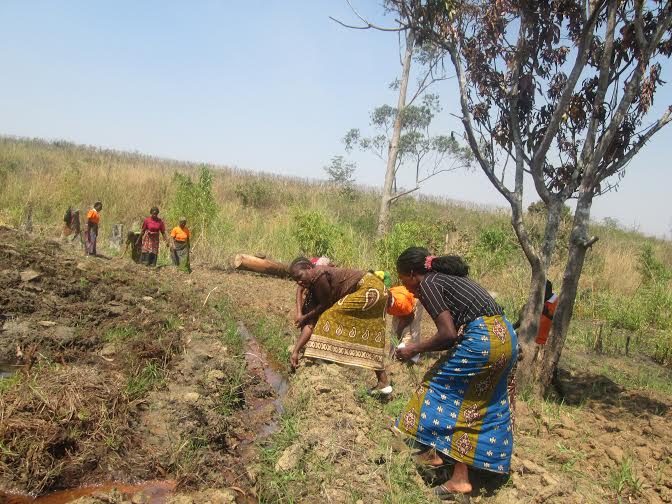 There are over 10 million people worldwide who have been displaced from their homes and sources of earnings by failed rains, rising seas and other climate related factors according to the United Nations Framework Convention on Climate Change. This group now christened climate refugees is emerging as the next biggest headache for policy makers as the effects of climate change intensifies exceeding earlier predictions.
There are over 10 million people worldwide who have been displaced from their homes and sources of earnings by failed rains, rising seas and other climate related factors according to the United Nations Framework Convention on Climate Change. This group now christened climate refugees is emerging as the next biggest headache for policy makers as the effects of climate change intensifies exceeding earlier predictions.
Nowhere is this effect more felt than in Africa where the bulk of the population rely on agriculture, the worst hit sector by climate change, for livelihoods. 80 percent of African farmers count on rainfed agriculture which has been particularly hit by the vagaries of weather.
Scientists are already predicting catastrophic effects in years to come which will take their toll on Africa’s most primed agricultural crops. They observe that at the current rate of temperature increase, global average temperatures will have increased 1.5°C by 2050. The latest science estimates the average production losses by 2050 for African maize at 22 per cent, sorghum 17 per cent, millet 17 per cent,groundnut 18 per cent and cassava 8 per cent.
Kenya, a country that the Food and Agricultural Organization FAO, has classed as so verdant and among the few capable of generating enough food for the entire continent turning it into an agricultural supply station is already bearing the brunt of changes in weather.
Over one million Kenyans have moved from where they traditionally lived or obtained their sources of income, as rains fail, or floods take toll on livelihoods according to the Kenya National Climate Change Action Plan.
,Majority of them have been farmers who have counted on their farms for generations to feed them and generate income to educate their children, open other businesses and take care of their other needs like health.
But what used to be verdant farms and lush produce has now turned to barren rocky lands. Phenomena unprecedented in Kenya are now a familiar sight thanks to climate change. Central and Rift Valley areas of Kenya, the prime producers of tea, have in the recent past experienced frost which has wiped entire plantations.
In 2012 for example data according to Kenya Tea Board indicated that on average farmers lost 60 percent of their tea income to the frost and with tea being one of the country’s key foreign exchange earner, the country lost $15million in failed exports in that year alone. Farmers unable to fight back are now fleeing their farms for greener pastures which are not so green.
They find haven in cities which are already choking with overpopulation. Kenya’s urban population stands at 24 percent of the total population but is projected to rise by upto 60 percent in 2030 according to the Kenya Demographics. The projected meteoric rise is attributed to rural urban migration which has recorded a steady rise in the last two years.
According to the Nairobi County government annual survey out of all the total population coming to cities from the rural areas, 30 percent is fleeing as a result of failed agricultural practices caused by failed rains. The locus of poverty is gradually shifting from rural to urban areas and is manifested in growing food insecurity with majority of those coming to the cities finding themselves worse off economically than they were back in the rural homes. A fifth of Nairobi residents are “ultra-hungry”, researchers say. Jobs in the cities are not forthcoming.
And in a bid to survive in harsh times in the cities, once food producers now turned food beggars are turning to other ways of earning income including social vices like robberies, muggings and prostitution. The Kenya Police crime index report indicates that in 2013 alone there was a spike in robberies, muggings and home break ins which the police attributed to growing list of jobless youth.
Western Kenya an area that was traditionally Kenya’s food basket has turned to a basket case with the only evidence of any farming activities to have ever taken place being dried maize cobs sitting next to animal corpses. From cow pea projects by youth groups that used to feed an entire region to banana value addition enterprises by single mothers in the areas, the machines have come to a halt and the hands that worked their way in the farms have sought refuge in city slums.
But even as Kenya struggles with its internal climate refugees, thousands more are trickling in from neighbouring Somalia and Ethiopia and are hosted in Dadaab camp in North Eastern Kenya, one of the largest in the world. While traditionally majority of the refugees in Daadab camp have fled wars, The International Red Cross estimates that there are more environmental refugees than political refugees fleeing from wars and other conflicts. According to the institution, wars in the region are usually rooted in competition for resources. Climate change has served to intensify that fighting.
And as Kenya struggles to feed its burgeoning population while addressing the twin problems of climate change and the refugees it is creating, industry players warn that if nothing is done half of all rural population in Kenya, which forms the bulk of the Kenyan population, will be climate refugees by 2030.
















Comments powered by CComment